Neutralizing blood-borne polyphosphate in vivo provides safe thromboprotection
- PMID: 27596064
- PMCID: PMC5025862
- DOI: 10.1038/ncomms12616
Neutralizing blood-borne polyphosphate in vivo provides safe thromboprotection
Abstract
Polyphosphate is an inorganic procoagulant polymer. Here we develop specific inhibitors of polyphosphate and show that this strategy confers thromboprotection in a factor XII-dependent manner. Recombinant Escherichia coli exopolyphosphatase (PPX) specifically degrades polyphosphate, while a PPX variant lacking domains 1 and 2 (PPX_Δ12) binds to the polymer without degrading it. Both PPX and PPX_Δ12 interfere with polyphosphate- but not tissue factor- or nucleic acid-driven thrombin formation. Targeting polyphosphate abolishes procoagulant platelet activity in a factor XII-dependent manner, reduces fibrin accumulation and impedes thrombus formation in blood under flow. PPX and PPX_Δ12 infusions in wild-type mice interfere with arterial thrombosis and protect animals from activated platelet-induced venous thromboembolism without increasing bleeding from injury sites. In contrast, targeting polyphosphate does not provide additional protection from thrombosis in factor XII-deficient animals. Our data provide a proof-of-concept approach for combating thrombotic diseases without increased bleeding risk, indicating that polyphosphate drives thrombosis via factor XII.
Figures
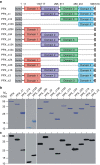

 =PPX variant,
=PPX variant,  =6xHis-tag antibody and
=6xHis-tag antibody and  =HRP-coupled detection antibody. Shown are relative amounts of PPX variants binding to polyP. Data blotted relative to full-size PPX, set to 1.0. Mean±s.e.m., n=4, ***P<0.001 by Student's t-test. (c) Gel mobility shift assay of full-size PPX, PPX_Δ1, PPX_Δ2, PPX_Δ12 and PPX_Δ124 binding to polyP. Increasing concentrations of PPX mutants (0–400 nM) were incubated with polyP (7.5 μg ml−1) for 30 min, and reaction mixtures containing 0–8 pmol mutant protein per lane were resolved on 1% agarose gels. PolyP was visualized with DAPI-negative staining and synthetic polyP with mean chain length of 383 and 637 phosphate units served as molecular size standard. (d) PPX_Δ12 (400 nM) was incubated for 30 min with increasing concentrations of various polyanions including LC polyP, SC polyP, dextran sulfate (DXS), oversulfated chondroitin sulfate (OSCS), DNA, RNA, chondroitin sulfate (CS), dermatan sulfate (DS) and heparan sulfate (HS). PPX_Δ12/polyanion complexes were dissolved on urea-polyacrylamide gels and PPX_Δ12 protein was stained with Coomassie brilliant blue. The dashed line gives PPX_Δ12/polyanion complex formation assessed by densitometric scans. A representative gel of three independent experiments is shown.
=HRP-coupled detection antibody. Shown are relative amounts of PPX variants binding to polyP. Data blotted relative to full-size PPX, set to 1.0. Mean±s.e.m., n=4, ***P<0.001 by Student's t-test. (c) Gel mobility shift assay of full-size PPX, PPX_Δ1, PPX_Δ2, PPX_Δ12 and PPX_Δ124 binding to polyP. Increasing concentrations of PPX mutants (0–400 nM) were incubated with polyP (7.5 μg ml−1) for 30 min, and reaction mixtures containing 0–8 pmol mutant protein per lane were resolved on 1% agarose gels. PolyP was visualized with DAPI-negative staining and synthetic polyP with mean chain length of 383 and 637 phosphate units served as molecular size standard. (d) PPX_Δ12 (400 nM) was incubated for 30 min with increasing concentrations of various polyanions including LC polyP, SC polyP, dextran sulfate (DXS), oversulfated chondroitin sulfate (OSCS), DNA, RNA, chondroitin sulfate (CS), dermatan sulfate (DS) and heparan sulfate (HS). PPX_Δ12/polyanion complexes were dissolved on urea-polyacrylamide gels and PPX_Δ12 protein was stained with Coomassie brilliant blue. The dashed line gives PPX_Δ12/polyanion complex formation assessed by densitometric scans. A representative gel of three independent experiments is shown.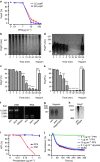


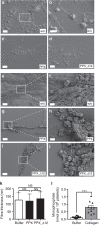
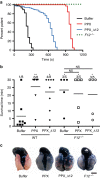
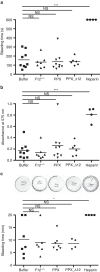
Similar articles
-
A Flow Cytometry-Based Assay for Procoagulant Platelet Polyphosphate.Cytometry B Clin Cytom. 2018 Mar;94(2):369-373. doi: 10.1002/cyto.b.21492. Epub 2016 Nov 28. Cytometry B Clin Cytom. 2018. PMID: 27813345
-
The polyphosphate/factor XII pathway in cancer-associated thrombosis: novel perspectives for safe anticoagulation in patients with malignancies.Thromb Res. 2016 May;141 Suppl 2:S4-7. doi: 10.1016/S0049-3848(16)30353-X. Thromb Res. 2016. PMID: 27207422 Review.
-
Coagulation factor XII in thrombosis and inflammation.Blood. 2018 Apr 26;131(17):1903-1909. doi: 10.1182/blood-2017-04-569111. Epub 2018 Feb 26. Blood. 2018. PMID: 29483100 Review.
-
Platelet polyphosphates: the nexus of primary and secondary hemostasis.Scand J Clin Lab Invest. 2011 Apr;71(2):82-6. doi: 10.3109/00365513.2010.550312. Scand J Clin Lab Invest. 2011. PMID: 21385010 Review.
-
The polyphosphate-factor XII pathway drives coagulation in prostate cancer-associated thrombosis.Blood. 2015 Sep 10;126(11):1379-89. doi: 10.1182/blood-2015-01-622811. Epub 2015 Jul 7. Blood. 2015. PMID: 26153520 Free PMC article.
Cited by
-
A Pathophysiological Perspective on the SARS-CoV-2 Coagulopathy.Hemasphere. 2020 Aug 10;4(4):e457. doi: 10.1097/HS9.0000000000000457. eCollection 2020 Aug. Hemasphere. 2020. PMID: 32885147 Free PMC article. Review.
-
Excessive release of inorganic polyphosphate by ALS/FTD astrocytes causes non-cell-autonomous toxicity to motoneurons.Neuron. 2022 May 18;110(10):1656-1670.e12. doi: 10.1016/j.neuron.2022.02.010. Epub 2022 Mar 10. Neuron. 2022. PMID: 35276083 Free PMC article.
-
The Central Role of Extracellular Vesicles in the Mechanisms of Thrombosis in COVID-19 Patients With Cancer and Therapeutic Strategies.Front Cell Dev Biol. 2022 Jan 12;9:792335. doi: 10.3389/fcell.2021.792335. eCollection 2021. Front Cell Dev Biol. 2022. PMID: 35096822 Free PMC article. Review.
-
Red blood cell microvesicles activate the contact system, leading to factor IX activation via 2 independent pathways.Blood. 2020 Mar 5;135(10):755-765. doi: 10.1182/blood.2019001643. Blood. 2020. PMID: 31971571 Free PMC article.
-
Fluorometric Quantification of Human Platelet Polyphosphate Using 4',6-Diamidine-2-phenylindole Dihydrochloride: Applications in the Japanese Population.Int J Mol Sci. 2021 Jul 6;22(14):7257. doi: 10.3390/ijms22147257. Int J Mol Sci. 2021. PMID: 34298874 Free PMC article.
References
-
- Eikelboom J. W. & Weitz J. I. New anticoagulants. Circulation 121, 1523–1532 (2010). - PubMed
-
- Franchini M., Mengoli C., Cruciani M., Bonfanti C. & Mannucci P. M. Effects on bleeding complications of pharmacogenetic testing for initial dosing of vitamin K antagonists: a systematic review and meta-analysis. J. Thromb. Haemost. 12, 1480–1487 (2014). - PubMed
-
- Baber U., Mastoris I. & Mehran R. Balancing ischaemia and bleeding risks with novel oral anticoagulants. Nat. Rev. Cardiol. 11, 693–703 (2014). - PubMed
-
- Kornberg A., Rao N. N. & Ault-Riche D. Inorganic polyphosphate: a molecule of many functions. Annu. Rev. Biochem. 68, 89–125 (1999). - PubMed
Publication types
MeSH terms
Substances
Grants and funding
LinkOut - more resources
Full Text Sources
Other Literature Sources
Medical
Molecular Biology Databases

